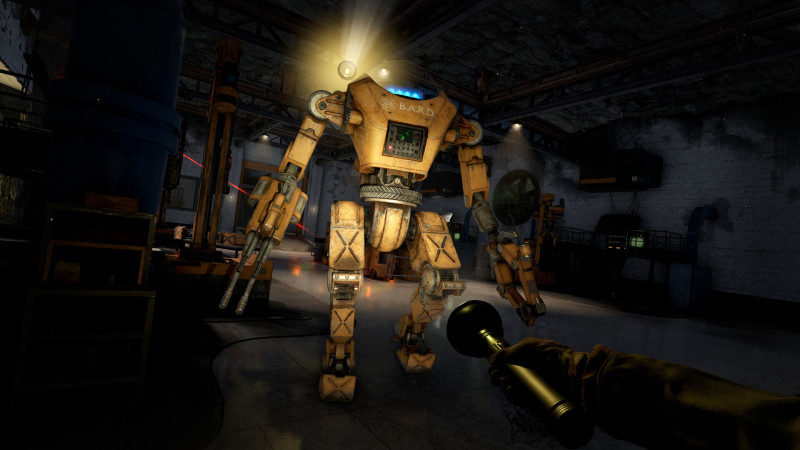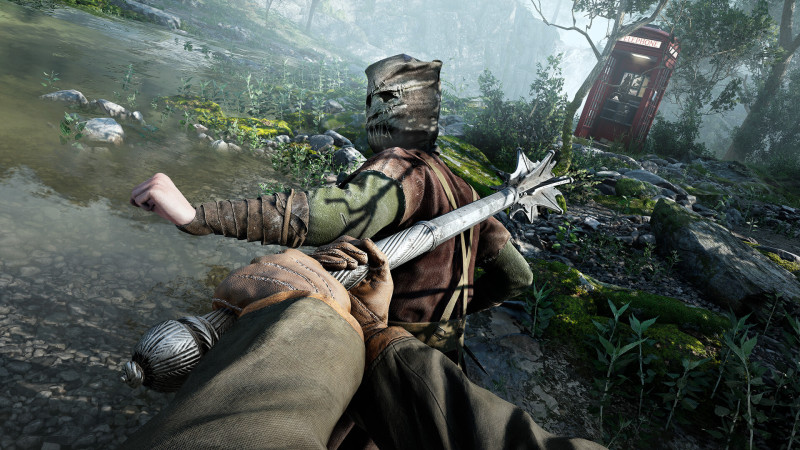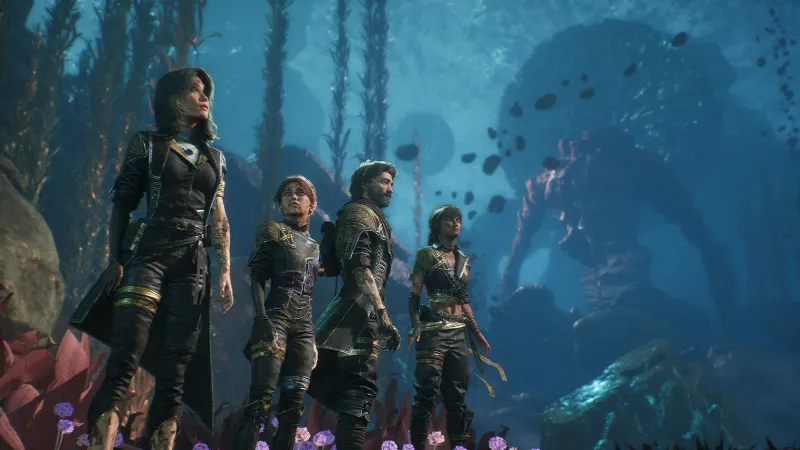Atomfall is committed to creating friction. It’s an open-world survival shooter that wants you to struggle to make success feel sweeter, but it does so with varying levels of effectiveness. When tuned correctly, it’s a blast. The survival elements, exploration, and quest structure are positive examples, but poor skill progression and a thin plot hold it back from the greatness it strives for.
The streets of Wyndham, Atomfall’s main village.
Atomfall’s lore intrigued me, but its narrative failed to hold my attention. In the years following the Second World War, the UK stumbled upon a mysterious discovery that it hoped could turn the Cold War in its favor. However, once it became clear that the discovery was uniquely dangerous, the government walled off the whole zone and quarantined thousands of people inside. This concept is ripe with opportunity, and while I enjoyed exploring the hostile pseudo-apocalypse, the premise is largely underutilized. The location is a great opportunity to explore the humanity of people pushed to extreme circumstances, which seems to be a larger theme of the game, but the main factions are cookie-cutter examples from the genre. A familiar military organization, a group of pagan druids, and a loose camp of anarchistic outlaws all exist, but none of them are explored past the surface level.
Atomfall’s general approach to narrative left me feeling like more of an observer of the world than an active participant. The protagonist wakes up within the walls with no connection to any of the people there, but they also have no memory of their life before, so character motivation is absent, leaving nothing left to pull the player along. Because of this, when characters ask you to do things, whether rescuing someone from prison, killing a group of people, or even just escaping the quarantine, you do them out of a broad sense of curiosity rather than any investment in the plot. The main quest-giver, who you encounter regardless of your narrative decisions, is a disembodied voice on a telephone, and the game’s ending doesn’t provide a satisfying answer about the voice’s owner.

You also fight some giant robots.
It doesn’t help that most NPCs outside of quest-givers can’t talk to you. When running around the streets of Wyndham trying to get a sense of the area’s vibe, I’m met with cold stares and blank expressions from the people walking about, and my only option for interaction is to knock them out like I would a guard. When you’re not in a safe zone, enemies of all factions shoot on sight if you get too close. Most engagement with the world is through old scraps of paper scavenged off dead bodies, and it’s hard to feel connected to that.
Atomfall’s strengths lie in its gameplay, particularly when exploring a new area. The game is split into a few sectioned-off open areas, so it’s not a true open world but a handful of open areas, which fits Atomfall’s modest scope well. Quests direct you to landmarks in a general area, so even when you know where you’re going, you still think critically about it, looking with your eyes in addition to the map in the menu. The mission structure has a similar approach, where objectives open up only once you piece together enough details from conversations or notes. I enjoyed how it pushes the player to really engage with the world.
The game’s survival elements kept me similarly invested in my surroundings. Resources are scarce, and everything you find is either taken from a corpse, crafted from ingredients, or bartered for with a small handful of traders. I can’t count the number of times I desperately rummaged through a structure, hunting for just one more piece of cloth to bandage my wounds. Crafting, healing, and swapping weapons happen in the menu in real-time, meaning you can’t pause to get your bearings and heal yourself. Hiding in a corner to reload frantically and fashion grenades is consistently thrilling.

The metal detector, pictured here, can be used to find small hidden crates of resources.
Guns feel great to fire, and I particularly enjoyed how many weapons, like the rifle and the shotgun, have to be reloaded after almost every shot. Bullets are valuable and powerful, and it’s easy to push back the despair of a missed shot in pursuit of a satisfying headshot. A minimal HUD means that to check your remaining ammunition, the player character looks in the gun’s chamber to see how many bullets remain. Little touches like this kept me immersed. That said, combat is particularly unforgiving. Just a few shots can kill you, potentially frustrating some players when facing off against large groups, especially early in the game. Thankfully, Atomfall includes robust options to tune difficulty to each player’s needs.
If you want to keep playing on a hard difficulty, stealth seems like an appealing alternate solution to combat, but Atomfall is lacking in that department. The only tool at your disposal to avoid combat is to crouch, and patches of tall grass aren’t common enough to be a reliable hiding spot. Enemies also have incredibly long lines of sight, and I was often detected before I could even see my opponents. I ultimately had to go into the accessibility settings to turn on detection markers, which create floating red skulls over enemy heads, just to fight back. To make matters worse, nearly any action attracts enemy attention: even takedowns, done by sneaking up on an unsuspecting enemy, immediately alert nearby combatants.
I ultimately abandoned these attempts altogether, nixing the subtle approach and opting to open encounters with a well-placed rifle shot, but it never felt like a suitable replacement. Going guns blazing into enemy camps is ill-advised, but when the alternative works zero percent of the time, I have no choice but to repeat risky maneuvers and buckle in for a handful of reloads after my inevitable chain of deaths.

Stealth skills can be unlocked and upgraded, but this fact isn’t clear due to the progression system. Skills can only be unlocked by finding training manuals, which add abilities to the upgrade menu that can be purchased using a rare resource called Training Stimulants. While I found it exciting to discover these booklets in the wild, not using an experience-driven approach meant missing certain trees was easy and frustrating. It doesn’t help that you can’t even see the categories of trees you don’t have, like the stealth tree, to search for them and make the game more enjoyable. I can’t imagine my experience if I hadn’t found the book that allows you to upgrade weapons or carry more crafting supplies.
I don’t regret my time with Atomfall. It knows what it wants to be, with a reasonable scope and solid shooting mechanics. But issues with the skill system, its underbaked stealth, and an unengaging narrative are asterisks too large to ignore. Like the world it depicts, something exciting and unique lies at Atomfall’s core. I just wish it wasn’t walled off by my laundry list of frustrations.












